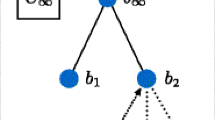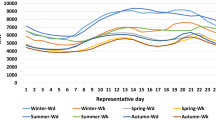Abstract
This paper deals with the modeling of power flow in a transmission grid within the multi-sectoral multi-energy long-term regional energy model ETEM-SG. This extension of the model allows a better representation of demand response for flexible loads triggered by nodal marginal cost pricing. To keep the global model in the realm of linear programming one uses a linearized DC power flow model that represents the transmission grid with the main constraints on the power flowing through the different arcs of the electricity transmission network. Robust optimization is used to take into account the uncertainty on the capacity limits resulting from inter-regional transit. A numerical illustration is carried out for a data set corresponding roughly to the Leman Arc region.








Similar content being viewed by others
Notes
Usually the swing bus is numbered 1 for the load flow studies. This bus sets the angular reference for all the other buses. Since it is the angle difference between two voltage sources that dictates the real and reactive power flow between them, the particular angle of the swing bus is not important.
In electrical engineering, susceptance (\({\mathbf {B}}\)) is the imaginary part of admittance. The inverse of admittance is impedance and the real part of admittance is conductance. In SI units, susceptance is measured in siemens.
Expressed in $/MWh or CHF/MWh.
References
Andrey, C., Babonneau, F., & Haurie, A. (2015). Modélisation stochastique et robuste de l’atténuation et de l’adaptation dans un système énergétique régional. application à la région midi-pyrénées. Nature Science Société, 23(2), 133–149.
Babonneau, F., Caramanis, M., & Haurie, A. (2016). A linear programming model for power distribution with demand response and variable renewable energy. Applied Energy, 181, 83–95.
Babonneau, F., Caramanis, M., & Haurie, A. (2017). ETEM-SG: Optimizing regional smart energy system with power distribution constraints and options. Environmental Modelling and Assessment, 22(5), 411–430.
Babonneau, F., Haurie, A., Tarel, G. J., & Thénié, J. (2012). Assessing the future of renewable and smart grid technologies in regional energy systems. Swiss Journal of Economics and Statistics, 148(2), 229–273.
Babonneau, F., Kanudia, A., Labriet, M., Loulou, R., & Vial, J.-P. (2012). Energy security: A robust programming approach and application to european energy supply via tiam. Environmental Modeling and Assessment, 17(1), 19–37.
Babonneau, F., Klopfenstein, O., Ouorou, A., & Vial, J.-P. (2013). Robust capacity expansion solutions for telecommunication networks with uncertain demands. Network, 62(4), 255–272.
Babonneau, F., Vial, J.-P., & Apparigliato, R. (2010). Robust optimization for environmental and energy planning. In J. A. Filar & A. Haurie (Eds.), Uncertainty and environmental decision making. Berlin: Springer.
Bacher, R. (1992). Power system models, objectives and constraints in optimal power flow calculations. In R. Bacher, K. Frauendorfer, & H. Glavitsch (Eds.), Optimization in planning and operation of electric power systems (pp. 217–264)., Lecture notes of the SVOR/ASRO tutorial Thun Berlin: Springer.
Ben-Tal, A., El Ghaoui, L., & Nemirovski, A. (2009). Robust optimization. Princeton: Princeton University Press.
Ben-Tal, A., & Nemirovski, A. (1998). Robust convex optimization. Mathematics of Operations Research, 23, 769–805.
Berger, C., Dubois, R., Haurie, A., Lessard, E., Loulou, R., & Waaub, J.-P. (1992). Canadian MARKAL: An advanced linear programming system for energy and environmental modelling. INFOR, 30(3), 222–239.
El-Ghaoui, L., & Lebret, H. (1997). Robust solutions to least- square problems to uncertain data matrices. SIAM Journal of Matrix Analysis and Applications, 18, 1035–1064.
Fragnière, E., & Haurie, A. (1996). A stochastic programming model for energy/environment choices under uncertainty. International Journal Environment and Pollution, 6(4–6), 587–603.
Loulou, R., & Labriet, M. (2008). ETSAP-TIAM: The times integrated assessment model part i: Model structure. Computational Management Science, 5(1), 7–40.
Office fédéral de l’énergie (OFEN). (2012). Die Energieperspektiven für die Schweiz bis 2050.
ORDECSYS. (2013). Réseaux intelligents de transport/transmission de l’électricité en suisse. Technical report, ORDECSYS Technical report.
ORDECSYS. (2014). Time of use (TOU) pricing: Adaptive and TOU pricing schemes for smart technology integration. Technical report, ORDECSYS Technical report.
Ruiz, P.A., Foster, J.M., Rudkevich, A., Caramanis, M. (2011) On fast transmission topology control heuristics. In Proceedings of 2011 IEEE power and energy society general meeting, Detroit, MI. IEEE, July 2011
Ruiz, P.A., Rudkevich, A., Caramanis, M.C., Goldis, E., Ntakou, E., Philbrick, R. (2012a). Reduced MIP formulation for transmission topology control. In 50th annual Allerton conference on communication, control, and computing, Monticello. USA University of Illinois at Urbana-Champaign
Ruiz, P. A., Foster, J. M., Rudkevich, A., & Caramanis, M. C. (2012). Tractable transmission topology control using sensitivity analysis. IEEE Transactions on Power Systems, 27, 1550–1559.
Soyster, A. L. (1973). Convex programming with set-inclusive constraints and applications to inexact linear programming. Operations Research, 21, 1154–1157.
Stiel, A. D. J. (2011). Modelling liberalised power markets. Master’s thesis. ETH Zürich, Centre for Energy Policy and Economics. September 2011
Weigt, H., & Schlecht, I. (2014). Swissmod a model of the Swiss electricity market. Technical report. WWZ-Discussion Paper.
Acknowledgements
This research is supported by the Qatar National Research Fund under Grant Agreement n\(^o\) NPRP10-0212-170447 and by Canadian IVADO programme (VORTEX Project).
Author information
Authors and Affiliations
Corresponding author
Rights and permissions
About this article
Cite this article
Babonneau, F., Haurie, A. Energy technology environment model with smart grid and robust nodal electricity prices. Ann Oper Res 274, 101–117 (2019). https://doi.org/10.1007/s10479-018-2920-1
Published:
Issue Date:
DOI: https://doi.org/10.1007/s10479-018-2920-1




